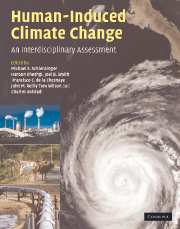Book contents
- Frontmatter
- Contents
- List of contributors
- Preface
- Part I Climate system science
- Part II Impacts and adaptation
- Part III Mitigation of greenhouse gases
- 15 Bottom-up modeling of energy and greenhouse gas emissions: approaches, results, and challenges to inclusion of end-use technologies
- 16 Technology in an integrated assessment model: the potential regional deployment of carbon capture and storage in the context of global CO2 stabilization
- 17 Hydrogen for light-duty vehicles: opportunities and barriers in the United States
- 18 The role of expectations in modeling costs of climate change policies
- 19 A sensitivity analysis of forest carbon sequestration
- 20 Insights from EMF-associated agricultural and forestry greenhouse gas mitigation studies
- 21 Global agricultural land-use data for integrated assessment modeling
- 22 Past, present, and future of non-CO2 gas mitigation analysis
- 23 How (and why) do climate policy costs differ among countries?
- 24 Lessons for mitigation from the foundations of monetary policy in the United States
- Part IV Policy design and decisionmaking under uncertainty
- Index
- Plate section
- References
22 - Past, present, and future of non-CO2 gas mitigation analysis
from Part III - Mitigation of greenhouse gases
Published online by Cambridge University Press: 06 December 2010
- Frontmatter
- Contents
- List of contributors
- Preface
- Part I Climate system science
- Part II Impacts and adaptation
- Part III Mitigation of greenhouse gases
- 15 Bottom-up modeling of energy and greenhouse gas emissions: approaches, results, and challenges to inclusion of end-use technologies
- 16 Technology in an integrated assessment model: the potential regional deployment of carbon capture and storage in the context of global CO2 stabilization
- 17 Hydrogen for light-duty vehicles: opportunities and barriers in the United States
- 18 The role of expectations in modeling costs of climate change policies
- 19 A sensitivity analysis of forest carbon sequestration
- 20 Insights from EMF-associated agricultural and forestry greenhouse gas mitigation studies
- 21 Global agricultural land-use data for integrated assessment modeling
- 22 Past, present, and future of non-CO2 gas mitigation analysis
- 23 How (and why) do climate policy costs differ among countries?
- 24 Lessons for mitigation from the foundations of monetary policy in the United States
- Part IV Policy design and decisionmaking under uncertainty
- Index
- Plate section
- References
Summary
Introduction
“Other greenhouse gases” (OGHGs) and “non-CO2 greenhouse gases” (NCGGs): these are terms that are now much more familiar to the climate modeling community than they were a decade ago. Much of the increased analytical relevance of these gases, which include methane, nitrous oxide, and a group of fluorinated compounds, is due to work conducted under the Stanford Energy Modeling Forum (EMF) and facilitated by meetings at Snowmass, Colorado, going back to 1998.
The two principal insights from over five years of analysis on NCGGs are (1) the range of economic sectors from which these emissions originate is far larger and more diverse than for carbon dioxide (CO2); and (2) the mitigation costs for these sectors and their associated gases can be lower than for energy-related CO2. Taken together, these two factors result in a larger portfolio of potential mitigation options, and thus more potential for reduced costs, for a given climate policy objective. This is especially important where carbon dioxide is not the dominant gas, on a percentage basis, for a particular economic sector and even for a particular region.
This paper provides an analytical history of non-CO2 work and also lays out promising new areas of further research. There are five sections following this introduction. Section 22.2 provides a summary of non-CO2 gases and important economic sectors. Section 22.3 covers early efforts to estimate non-CO2 emissions and mitigation potential. Section 22.5 covers recent work focusing on mitigation.
- Type
- Chapter
- Information
- Human-Induced Climate ChangeAn Interdisciplinary Assessment, pp. 266 - 281Publisher: Cambridge University PressPrint publication year: 2007



